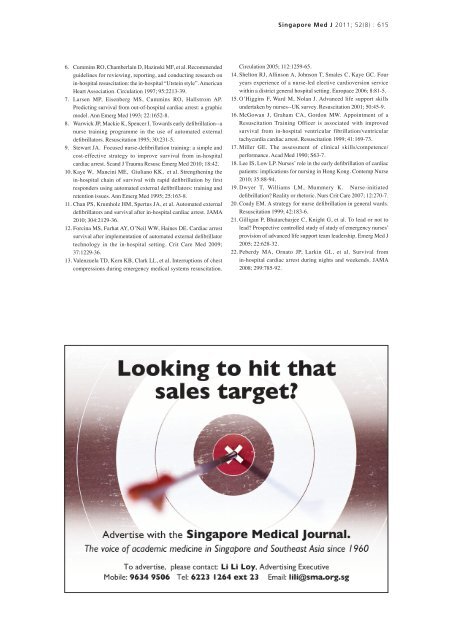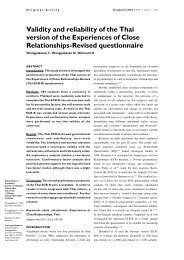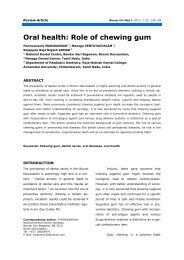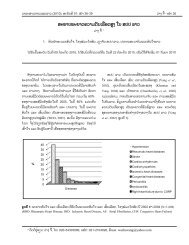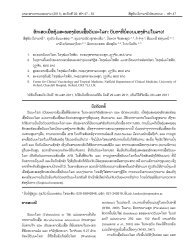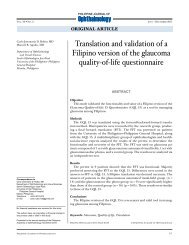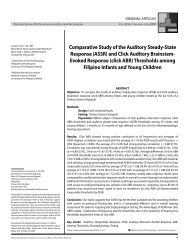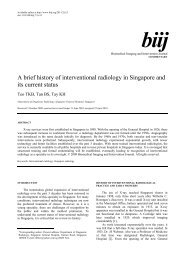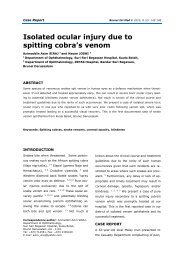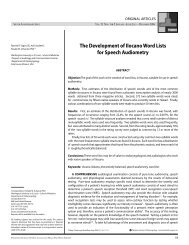PDF ( B) - APAMED Central
PDF ( B) - APAMED Central
PDF ( B) - APAMED Central
Create successful ePaper yourself
Turn your PDF publications into a flip-book with our unique Google optimized e-Paper software.
Singapore Med J 2011; 52(8) : 615<br />
6. Cummins RO, Chamberlain D, Hazinski MF, et al. Recommended<br />
guidelines for reviewing, reporting, and conducting research on<br />
in-hospital resuscitation: the in-hospital “Utstein style”. American<br />
Heart Association. Circulation 1997; 95:2213-39.<br />
7. Larsen MP, Eisenberg MS, Cummins RO, Hallstrom AP.<br />
Predicting survival from out-of-hospital cardiac arrest: a graphic<br />
model. Ann Emerg Med 1993; 22:1652-8.<br />
8. Warwick JP, Mackie K, Spencer I. Towards early defibrillation--a<br />
nurse training programme in the use of automated external<br />
defibrillators. Resuscitation 1995; 30:231-5.<br />
9. Stewart JA. Focused nurse-defibrillation training: a simple and<br />
cost-effective strategy to improve survival from in-hospital<br />
cardiac arrest. Scand J Trauma Resusc Emerg Med 2010; 18:42.<br />
10. Kaye W, Mancini ME, Giuliano KK, et al. Strengthening the<br />
in-hospital chain of survival with rapid defibrillation by first<br />
responders using automated external defibrillators: training and<br />
retention issues. Ann Emerg Med 1995; 25:163-8.<br />
11. Chan PS, Krumholz HM, Spertus JA, et al. Automated external<br />
defibrillators and survival after in-hospital cardiac arrest. JAMA<br />
2010; 304:2129-36.<br />
12. Forcina MS, Farhat AY, O’Neil WW, Haines DE. Cardiac arrest<br />
survival after implementation of automated external defibrillator<br />
technology in the in-hospital setting. Crit Care Med 2009;<br />
37:1229-36.<br />
13. Valenzuela TD, Kern KB, Clark LL, et al. Interruptions of chest<br />
compressions during emergency medical systems resuscitation.<br />
Circulation 2005; 112:1259-65.<br />
14. Shelton RJ, Allinson A, Johnson T, Smales C, Kaye GC. Four<br />
years experience of a nurse-led elective cardioversion service<br />
within a district general hospital setting. Europace 2006; 8:81-5.<br />
15. O’Higgins F, Ward M, Nolan J. Advanced life support skills<br />
undertaken by nurses--UK survey. Resuscitation 2001; 50:45-9.<br />
16. McGowan J, Graham CA, Gordon MW. Appointment of a<br />
Resuscitation Training Officer is associated with improved<br />
survival from in-hospital ventricular fibrillation/ventricular<br />
tachycardia cardiac arrest. Resuscitation 1999; 41:169-73.<br />
17. Miller GE. The assessment of clinical skills/competence/<br />
performance. Acad Med 1990; S63-7.<br />
18. Lee IS, Low LP. Nurses’ role in the early defibrillation of cardiac<br />
patients: implications for nursing in Hong Kong. Contemp Nurse<br />
2010; 35:88-94.<br />
19. Dwyer T, Williams LM, Mummery K. Nurse-initiated<br />
defibrillation Reality or rhetoric. Nurs Crit Care 2007; 12:270-7.<br />
20. Coady EM. A strategy for nurse defibrillation in general wards.<br />
Resuscitation 1999; 42:183-6.<br />
21. Gilligan P, Bhatarcharjee C, Knight G, et al. To lead or not to<br />
lead Prospective controlled study of study of emergency nurses’<br />
provision of advanced life support team leadership. Emerg Med J<br />
2005; 22:628-32.<br />
22. Peberdy MA, Ornato JP, Larkin GL, et al. Survival from<br />
in-hospital cardiac arrest during nights and weekends. JAMA<br />
2008; 299:785-92.


